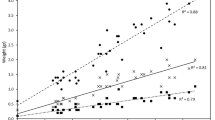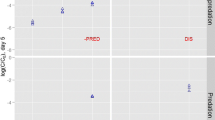Abstract
Studies on the survival of bacterial enteric pathogens in riverbed sediments have mostly focused on individual organisms. Reports on the competitive survival of these pathogens in riverbed sediments under the same experimental setup are limited. We investigated the survival of Escherichia coli, Salmonella enterica ser. Typhimurium, Vibrio cholerae and Shigella dysenteriae in riverbed sediments of the Apies River. Experiments were performed in flow chambers containing three sediment types and connected to aquarium pumps immersed in river water to maintain continuous water circulation. Each chamber was inoculated with ~107 CFU/mL (final concentration) of each microorganism and kept at 4, 20 and 30 °C. Chambers were sampled on days 0, 1, 2, 7, 14 and 28. At 4 °C, only E. coli and S. typhimurium survived throughout the 28 experimental days. V. cholerae had the shortest survival time at this temperature and was not detected in any of the sediment chambers 24 h after inoculation. S. dysenteriae only survived until day 7. At an increased temperature of 20 °C, only S. dysenteriae was not detected on day 28 of the experiment. At 30 °C, V. cholerae and Salmonella survived longer (28 days) than E. coli (14 days) and S. dysenteriae (4 days). Vibrio cholerae was shown to have the highest T 90 values (32 days) in all sediment types at 20 and 30 °C. We conclude that the sediments of the Apies River present a favourable environment for the survival of indicator and pathogenic bacteria depending on the prevailing temperature.



Similar content being viewed by others
References
Donovan EP, Staskal DF, Unice KM et al (2008) Risk of gastrointestinal disease associated with exposure to pathogens in the sediments of the Lower Passaic River. Appl Environ Microbiol 74:1004–1018. doi:10.1128/AEM.01203-07
Yamahara KM, Sassoubre LM, Goodwin KD, Boehm AB (2012) Occurrence and persistence of bacterial pathogens and indicator organisms in beach sand along the California coast. Appl Environ Microbiol 78:1733–1745. doi:10.1128/AEM.06185-11
Mueller-spitz SR, Stewart LB, Klump JV et al (2010) Freshwater suspended sediments and sewage are reservoirs for enterotoxin-positive Clostridium perfringens. Appl Environ Microbiol 76:5556–5562. doi:10.1128/AEM.01702-09
Niewolak S, Opieka A (2000) Potentially pathogenic microorganisms in water and bottom sediments in the Czarna Hańcza River. Polish J Environ Stud 9:183–194
Marshall KC, Stout R, Mitchell R (1971) Mechanism of the initial events in the sorption of marine bacteria to surfaces. J Gen Microbiol 68:337–348. doi:10.1099/00221287-68-3-337
Droppo IG, Liss SN, Williams D et al (2009) Dynamic existence of waterborne pathogens within river sediment compartments. implications for Water Quality Regulatory Affairs. Environ Sci Technol 43:1737–1743. doi:10.1021/es802321w
Burton GAJ, Gunnison D, Lanza GR (1987) Survial of pathogenic bacteria in various freshwater sediments. Appl Environ Microbiol 53:633–638
Davies C, Long J (1995) Survival of fecal microorganisms in marine and freshwater sediments. Appl Environ Microbiol 61:1888–1896
Craig D, Fallowfield H, Cromar N (2001) The effects of temperature and sediment characteristics on survival of Escherichia coli in recreational coastal water and sediment. Environ Health 1:43–51
Craig DL, Fallowfield HJ, Cromar NJ (2004) Use of microcosms to determine persistence of Escherichia coli in recreational coastal water and sediment and validation with in situ measurements. J Appl Microbiol 96:922–930. doi:10.1111/j.1365-2672.2004.02243.x
Rodríguez S, Araujo R (2012) Effect of environmental parameters on the inactivation of the waterborne pathogen Campylobacter in a Mediterranean river. J Water Health 10:100–107. doi:10.2166/wh.2011.044
Campos C, Kershaw S, Lee R (2013) Environmental influences on faecal indicator organisms in coastal waters and their accumulation in bivalve shellfish. Estuar Coasts 36:834–853. doi:10.1007/s12237-013-9599-y
du Preez M, Van der Merwe M, le Roux W (2010) A survey of Vibrio cholerae O1 and O139 in estuarine waters and sediments of Beira, Mozambique. Water SA 36:615–620
Moore BC, Martinez E, Gay JM, Rice DH (2003) Survival of Salmonella enterica in freshwater and sediments and transmission by the aquatic midge chironomus tentans (Chironomidae : Diptera). Appl Environ Microbiol 69:4556–4560. doi:10.1128/AEM.69.8.4556-4560.2003
Kinge CW, Mbewe M (2010) Characterisation of Shigella spesies isolated from river catchments in the North West Province of South Africa. S Afr J Sci 106:211. doi:10.4102/sajs.v106i11/12.211
Tammeorg O, Niemistö J, Möls T et al (2013) Wind-induced sediment resuspension as a potential factor sustaining eutrophication in large and shallow Lake Peipsi. Aquat Sci 75:559–570. doi:10.1007/s00027-013-0300-0
Mcdaniel RL, Soupir ML, Tuttle RB, Cervantes AE (2013) Release, dispersion and resuspension of Escherichia coli from direct fecal deposits under controlled flows. J Am Water Resour Assoc 49:319–327
Anderson KL, Whitlock JE, Harwood VJ (2005) Persistence and differential survival of fecal indicator bacteria in subtropical waters and sediments. Appl Environ Microbiol 71:3041–3048. doi:10.1128/AEM.71.6.3041-3048.2005
Sherer BM, Miner JR, Moore JA, Buckhouse JC (1992) Indicator bacterial survival in stream sediments. J Environ Qual 21:591–595
Chandran A, Mohamed Hatha AA (2005) Relative survival of Escherichia coli and Salmonella typhimurium in a tropical estuary. Water Res 39:1397–1403. doi:10.1016/j.watres.2005.01.010
Djaouda M, Gaké B, Ebang Menye D et al (2013) Survival and Growth of Vibrio cholerae, Escherichia coli, and Salmonella spp. in well water used for drinking purposes in Garoua (North Cameroon). Int J Bacteriol. doi:10.1155/2013/127179
Chandran A, Varghese S, Kandeler E et al (2011) An assessment of potential public health risk associated with the extended survival of indicator and pathogenic bacteria in freshwater lake sediments. Int J Hyg Environ Health 214:258–264. doi:10.1016/j.ijheh.2011.01.002
Pachepsky YA, Blaustein RA, Whelan G, Shelton DR (2014) Comparing temperature effects on Escherichia coli, Salmonella, and Enterococcus survival in surface waters. Lett Appl Microbiol 59:278–283. doi:10.1111/lam.12272
Hood MA, Ness GE (1982) Survival of Vibrio cholerae and Escherichia coli in estuarine waters and sediments. Appl Environ Microbiol 43:578–584
Garzio-hadzick A, Shelton DR, Hill RL et al (2010) Survival of manure-borne E. coli in streambed sediment: effects of temperature and sediment properties. Water Res 44:2753–2762. doi:10.1016/j.watres.2010.02.011
Abia LKA, Ubomba-Jaswa E, Ssemakalu CC, Momba MNB (2015) Development of a rapid approach for the enumeration of Escherichia coli in riverbed sediment: case study, the Apies River, South Africa. J Soils Sediments 15:2425–2432. doi:10.1007/s11368-015-1081-y
Herigstad B, Hamilton M, Heersink J (2001) How to optimize the drop plate method for enumerating bacteria. J Microbiol Methods 44:121–129
Davies CM, Evison LM (1991) Sunlight and the survival of enteric bacteria in natural waters. J Appl Bacteriol 70:265–274
Schang C, Osborne C, Deletic A, et al. (2012) Survival of pathogenic and faecal indicator bacteria in the bed and bank sediments of the Yarra River estuary, Australia. In: WSUD 2012 Water sensitive urban Des. Build. water sensiitve community; 7th Int. Conf. water sensitive urban Des. pp 568–575
Cabral JPS (2010) Water microbiology. Bacterial pathogens and water. Int J Environ Res Public Health 7:3657–3703. doi:10.3390/ijerph7103657
Kierek K, Watnick PI (2003) Environmental determinants of Vibrio cholerae biofilm development. Appl Environ Microbiol 69:5079–5088. doi:10.1128/AEM.69.9.5079-5088.2003
Craig DL, Fallowfield HJ, Cromar NJ (2002) Enumeration of faecal coliforms from recreational coastal sites: evaluation of techniques for the separation of bacteria from sediments. J Appl Microbiol 93:557–565
Lutz C, Erken M, Noorian P et al (2013) Environmental reservoirs and mechanisms of persistence of Vibrio cholerae. Front Microbiol 4:375. doi:10.3389/fmicb.2013.00375
Steenackers H, Hermans K, Vanderleyden J, De Keersmaecker SCJ (2012) Salmonella biofilms: an overview on occurrence, structure, regulation and eradication. Food Res Int 45:502–531. doi:10.1016/j.foodres.2011.01.038
Spector MP, Kenyon WJ (2012) Resistance and survival strategies of Salmonella enterica to environmental stresses. Food Res Int 45:455–481. doi:10.1016/j.foodres.2011.06.056
Ellafi A, Lagha R, Abdallah FB, Bakhrouf A (2012) Biofilm production, adherence and hydrophobicity of starved Shigella in seawater. African J Microbiol Res 6:4355–4359. doi:10.5897/AJMR11.1347
Mokhtari W, Nsaibia S, Gharbi A, Aouni M (2013) Real-time PCR using SYBR Green for the detection of Shigella spp. in food and stool samples. Mol Cell Probes 27:53–59. doi:10.1016/j.mcp.2012.09.002
Theron J, Morar D, du Preez M et al (2001) A sensitive seminested PCR method for the detection of Shigella in spiked environmental water samples. Water Res 35:869–874
Borgeaud S, Metzger LC, Scrignari T, Blokesch M (2015) The type VI secretion system of Vibrio cholerae fosters horizontal gene transfer. Science 347:63–67. doi:10.1126/science.1260064
Meibom KL, Li XB, Nielsen AT et al (2004) The Vibrio cholerae chitin utilization program. PNAS 101:2524–2529
Bai S, Lung W (2005) Modeling sediment impact on the transport of fecal bacteria. Water Res 39:5232–5240. doi:10.1016/j.watres.2005.10.013
Zhang Z, Deng Z, Rusch KA (2011) Development of predictive models for determining enterococci levels at Gulf Coast beaches. Water Res 46:465–474. doi:10.1016/j.watres.2011.11.027
Wu J, Rees P, Dorner S (2011) Variability of E. coli density and sources in an urban watershed. J Water Health 9:94–106. doi:10.2166/wh.2010.063
Robertson JB, Edberg SC (1997) Natural protection of spring and well drinking water against surface microbial contamination. I. Indicators and monitoring. Parameters for Parasites. Crit Rev Microbiol 23:143–178
Frey SK, Gottschall N, Wilkes G et al (2015) Rainfall-induced runoff from exposed streambed sediments: an important source of water pollution. J Environ Qual 44:236–247. doi:10.2134/jeq2014.03.0122
Smith DR, Haggard BE, Warnemuende EA, Huang C (2005) Sediment phosphorus dynamics for three tile fed drainage ditches in Northeast Indiana. Agric Water Manag 71:19–32. doi:10.1016/j.agwat.2004.07.006
Acknowledgments
The authors would like to thank the Water Research Commission (WRC), South Africa (WRC Projects K5/2169 and K5/2147), the National Research Foundation (NRF) of South Africa and the Tshwane University of Technology (TUT) for funding. The authors also thank Dr. Pachepsky of the US Department of Agriculture for providing them with the design for the chambers. However, opinions expressed and conclusions arrived at are those of the authors and are not necessarily to be attributed to the NRF, the WRC or TUT.
Author information
Authors and Affiliations
Corresponding authors
Rights and permissions
About this article
Cite this article
Abia, A.L.K., Ubomba-Jaswa, E. & Momba, M.N.B. Competitive Survival of Escherichia coli, Vibrio cholerae, Salmonella typhimurium and Shigella dysenteriae in Riverbed Sediments. Microb Ecol 72, 881–889 (2016). https://doi.org/10.1007/s00248-016-0784-y
Received:
Accepted:
Published:
Issue Date:
DOI: https://doi.org/10.1007/s00248-016-0784-y




